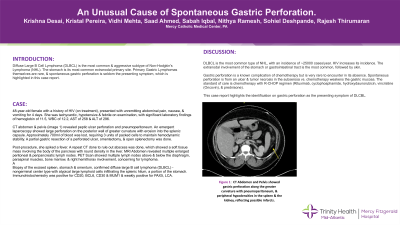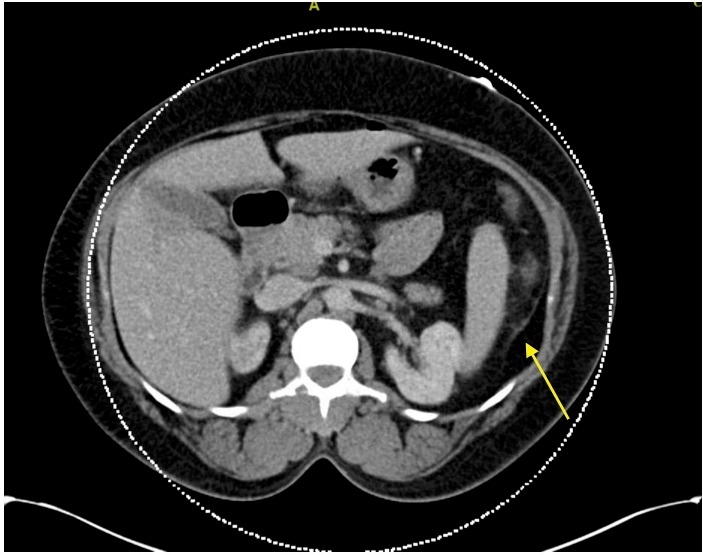Monday Poster Session
Category: GI Bleeding
P2100 - An Unusual Cause of Spontaneous Gastric Perforation
Monday, October 23, 2023
10:30 AM - 4:15 PM PT
Location: Exhibit Hall

Has Audio

Krishna Desai, MD
Mercy Catholic Medical Center
Philadelphia, PA
Presenting Author(s)
Krishna Desai, MD1, Kristal N. Pereira, MD1, Vidhi Mehta, MD2, Saad Ahmed, MD2, Sabah Iqbal, MBBS1, Mahvish Renzu, MD2, Nithya Ramesh, MD2, Sohiel Deshpande, MD2, Rajesh Thirumaran, MD2
1Mercy Catholic Medical Center, Philadelphia, PA; 2Mercy Catholic Medical Center, Darby, PA
Introduction: Diffuse Large B Cell Lymphoma (DLBCL) is the most common & aggressive subtype of Non-Hodgkin's Lymphoma (NHL). The stomach is its most common extranodal primary site. Primary Gastric Lymphomas themselves are rare, & spontaneous gastric perforation is seldom the presenting symptom, which is highlighted in this case report.
Case Description/Methods: A 48-year-old female with a history of HIV (on treatment), presented with unremitting abdominal pain, nausea, & vomiting for 4 days. She was tachycardic, hypotensive & febrile on examination, with significant laboratory findings of hemoglobin of 11.5, WBC of 12.2, AST of 258 & ALT of 296.
CT abdomen & pelvis (image 1) revealed peptic ulcer perforation and pneumoperitoneum. An emergent laparoscopy showed large perforation on the posterior wall of greater curvature with erosion into the splenic capsule. Approximately 700ml of blood was lost, requiring 3 units of packed cells to maintain hemodynamic stability. A partial gastric resection of a perforated ulcer, omentectomy, & open splenectomy was done.
Post-procedure, she spiked a fever. A repeat CT done to rule out abscess was done, which showed a soft tissue mass involving the body of the pancreas with round density in the liver. MRI Abdomen revealed multiple enlarged peritoneal & peripancreatic lymph nodes. PET Scan showed multiple lymph nodes above & below the diaphragm, paraspinal muscles, bone marrow, & right hemithorax involvement, concerning for lymphoma.
Biopsy of the excised spleen, stomach & omentum, confirmed diffuse large B cell lymphoma (DLBCL) - nongerminal center type with atypical large lymphoid cells infiltrating the splenic hilum, a portion of the stomach. Immunohistochemistry was positive for CD20, BCL6, CD30 & MUM1 & weakly positive for PAX5, LCA.
She was started on CHOP Rituxan as an outpatient.
Discussion: DLBCL is the most common type of NHL, with an incidence of ~25000 cases/year. HIV increases its incidence. The extranodal involvement of the stomach or gastrointestinal tract is the most common, followed by skin.
Gastric perforation is a known complication of chemotherapy but is very rare to encounter in its absence. Spontaneous perforation is from an ulcer & tumor necrosis in the subserosa vs. chemotherapy weakens the gastric mucosa. The standard of care is chemotherapy with R-CHOP regimen (Rituximab, cyclophosphamide, hydroxydaunorubicin, vincristine (Oncovin), & prednisone).
This case report highlights the identification on gastric perforation as the presenting symptom of DLCBL.

Disclosures:
Krishna Desai, MD1, Kristal N. Pereira, MD1, Vidhi Mehta, MD2, Saad Ahmed, MD2, Sabah Iqbal, MBBS1, Mahvish Renzu, MD2, Nithya Ramesh, MD2, Sohiel Deshpande, MD2, Rajesh Thirumaran, MD2. P2100 - An Unusual Cause of Spontaneous Gastric Perforation, ACG 2023 Annual Scientific Meeting Abstracts. Vancouver, BC, Canada: American College of Gastroenterology.
1Mercy Catholic Medical Center, Philadelphia, PA; 2Mercy Catholic Medical Center, Darby, PA
Introduction: Diffuse Large B Cell Lymphoma (DLBCL) is the most common & aggressive subtype of Non-Hodgkin's Lymphoma (NHL). The stomach is its most common extranodal primary site. Primary Gastric Lymphomas themselves are rare, & spontaneous gastric perforation is seldom the presenting symptom, which is highlighted in this case report.
Case Description/Methods: A 48-year-old female with a history of HIV (on treatment), presented with unremitting abdominal pain, nausea, & vomiting for 4 days. She was tachycardic, hypotensive & febrile on examination, with significant laboratory findings of hemoglobin of 11.5, WBC of 12.2, AST of 258 & ALT of 296.
CT abdomen & pelvis (image 1) revealed peptic ulcer perforation and pneumoperitoneum. An emergent laparoscopy showed large perforation on the posterior wall of greater curvature with erosion into the splenic capsule. Approximately 700ml of blood was lost, requiring 3 units of packed cells to maintain hemodynamic stability. A partial gastric resection of a perforated ulcer, omentectomy, & open splenectomy was done.
Post-procedure, she spiked a fever. A repeat CT done to rule out abscess was done, which showed a soft tissue mass involving the body of the pancreas with round density in the liver. MRI Abdomen revealed multiple enlarged peritoneal & peripancreatic lymph nodes. PET Scan showed multiple lymph nodes above & below the diaphragm, paraspinal muscles, bone marrow, & right hemithorax involvement, concerning for lymphoma.
Biopsy of the excised spleen, stomach & omentum, confirmed diffuse large B cell lymphoma (DLBCL) - nongerminal center type with atypical large lymphoid cells infiltrating the splenic hilum, a portion of the stomach. Immunohistochemistry was positive for CD20, BCL6, CD30 & MUM1 & weakly positive for PAX5, LCA.
She was started on CHOP Rituxan as an outpatient.
Discussion: DLBCL is the most common type of NHL, with an incidence of ~25000 cases/year. HIV increases its incidence. The extranodal involvement of the stomach or gastrointestinal tract is the most common, followed by skin.
Gastric perforation is a known complication of chemotherapy but is very rare to encounter in its absence. Spontaneous perforation is from an ulcer & tumor necrosis in the subserosa vs. chemotherapy weakens the gastric mucosa. The standard of care is chemotherapy with R-CHOP regimen (Rituximab, cyclophosphamide, hydroxydaunorubicin, vincristine (Oncovin), & prednisone).
This case report highlights the identification on gastric perforation as the presenting symptom of DLCBL.

Figure: CT Abdomen and Pelvis showed gastric perforation along the greater curvature with pneumoperitoneum, & peripheral hypodensities in the spleen & the kidney, reflecting possible infarcts.
Disclosures:
Krishna Desai indicated no relevant financial relationships.
Kristal Pereira indicated no relevant financial relationships.
Vidhi Mehta indicated no relevant financial relationships.
Saad Ahmed indicated no relevant financial relationships.
Sabah Iqbal indicated no relevant financial relationships.
Mahvish Renzu indicated no relevant financial relationships.
Nithya Ramesh indicated no relevant financial relationships.
Sohiel Deshpande indicated no relevant financial relationships.
Rajesh Thirumaran indicated no relevant financial relationships.
Krishna Desai, MD1, Kristal N. Pereira, MD1, Vidhi Mehta, MD2, Saad Ahmed, MD2, Sabah Iqbal, MBBS1, Mahvish Renzu, MD2, Nithya Ramesh, MD2, Sohiel Deshpande, MD2, Rajesh Thirumaran, MD2. P2100 - An Unusual Cause of Spontaneous Gastric Perforation, ACG 2023 Annual Scientific Meeting Abstracts. Vancouver, BC, Canada: American College of Gastroenterology.
